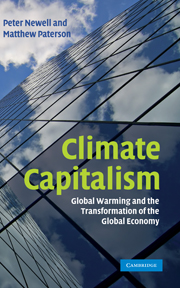Book contents
- Frontmatter
- Contents
- Preface
- Acknowledgements
- List of abbreviations
- 1 Introducing climate capitalism
- 2 Histories of climate, histories of capitalism
- 3 Climate for business: from threat to opportunity
- 4 Mobilising the power of investors
- 5 Searching for flexibility, creating a market
- 6 Caps, trades and profits
- 7 Buying our way out of trouble
- 8 The limits of climate capitalism
- 9 Governing the carbon economy
- 10 What futures for climate capitalism?
- Conclusions
- Glossary
- Index
- References
5 - Searching for flexibility, creating a market
Published online by Cambridge University Press: 05 June 2012
- Frontmatter
- Contents
- Preface
- Acknowledgements
- List of abbreviations
- 1 Introducing climate capitalism
- 2 Histories of climate, histories of capitalism
- 3 Climate for business: from threat to opportunity
- 4 Mobilising the power of investors
- 5 Searching for flexibility, creating a market
- 6 Caps, trades and profits
- 7 Buying our way out of trouble
- 8 The limits of climate capitalism
- 9 Governing the carbon economy
- 10 What futures for climate capitalism?
- Conclusions
- Glossary
- Index
- References
Summary
If you were sitting in Oslo, Norway, in 1991, as was Ted Hanisch, as the UN climate negotiations started, then two things would have been obvious to you. On the one hand, Norway has a strong tradition of environmental leadership. In the form of previous (and future) prime minister Gro Harlem Brundtland, it provided the chair of the World Commission on Environment and Development that popularised the term ‘sustainable development’. The country also has considerable achievements in reductions in various pollutants and a positive reputation for stringent environmental regulation. On the other hand, Norway is an oil producer and exporter, already heavily dependent on oil exports for growth and export earnings, and poised for a significant expansion of its oil operations. Public pressure and diplomatic reputation required Norway to play a positive role in the response to climate change. But emissions were projected to grow significantly because of the role of oil in the economy.
Hanisch was director-general at the Center for International Climate and Environmental Research (CICERO), a newly formed think-tank in Oslo. His response to this dilemma was to propose, in a paper produced in 1991, that countries ought to be able to meet their obligations to reduce their emissions jointly. This could take various forms – investment by one country in projects in another to offset their own emissions, joint projects to limit the emissions of both and so on.
- Type
- Chapter
- Information
- Climate CapitalismGlobal Warming and the Transformation of the Global Economy, pp. 78 - 93Publisher: Cambridge University PressPrint publication year: 2010



